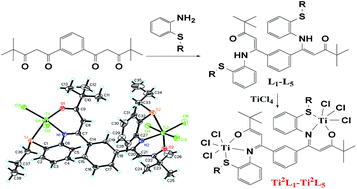Synthesis, characterization and olefin polymerization behaviors of phenylene-bridged bis-β-carbonylenamine binuclear titanium complexes†
Abstract
Binuclear and multinuclear complexes have attracted much attention due to their unique catalytic performances for olefin polymerization compared with their mononuclear counterparts. In this work, a series of phenyl-bridged bis-β-carbonylenamine [O−NSR] (R = alkyl or phenyl) tridentate ligands and their binuclear titanium complexes (Ti2L1–Ti2L5) were synthesized and characterized by 1H NMR, 13C NMR, FTIR and elemental analysis. The molecular structure of ligand L2 (R = nPr) and its corresponding Ti complex Ti2L2 were further investigated by single-crystal X-ray diffraction, which showed that each titanium coordinated with six atoms to form a distorted octahedral configuration along with the conversion of the ligand from β-carbonylenamine to β-imino enol form. Under the activation of MMAO, these complexes catalyzed ethylene polymerization and ethylene/α-olefin copolymerization with extremely high activity (over 106 g mol (Ti)−1 h−1 atm−1) to produce high molecular weight polyethylene. At the same time, wider polydispersity as compared with the mononuclear counterpart TiL6 was observed, indicating that two active catalytic centers may be present, consistent with the asymmetrical crystal structure of the binuclear titanium complex. Furthermore, these complexes possessed better thermal stability than their mononuclear analogues. Compared with the complexes bearing alkylthio sidearms, the complex Ti2L5 bearing a phenylthio sidearm exhibited higher catalytic activity towards ethylene polymerization and produced polyethylene with much higher molecular weight, but with an appreciably lower 1-hexene incorporation ratio. Nevertheless, these bis-β-carbonylenamine-derived binuclear titanium complexes showed much higher ethylene/1-hexene copolymerization activity and 1-hexene incorporation ratios as compared with the methylene-bridged bis-salicylaldiminato binuclear titanium complexes, and the molecular weight and 1-hexene incorporation ratio could be flexibly tuned by the initial feed of α-olefin commoners and catalyst structures.



 Please wait while we load your content...
Please wait while we load your content...